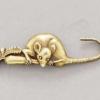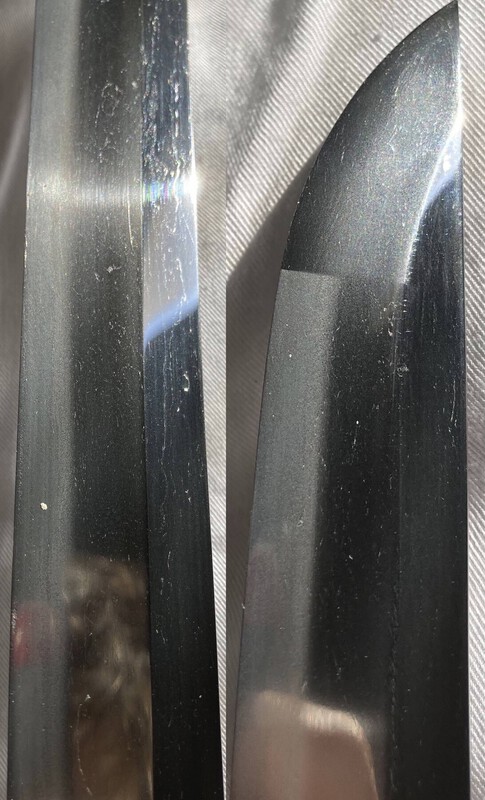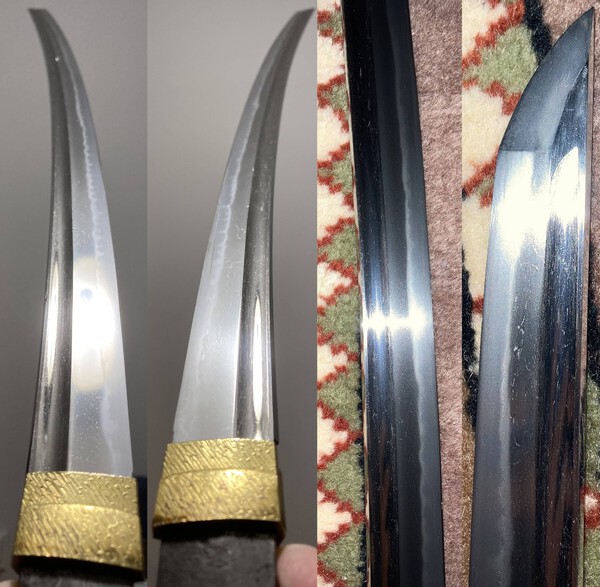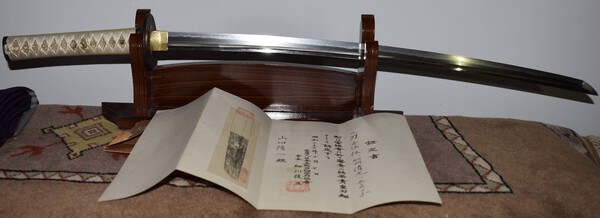-
Posts
253 -
Joined
-
Last visited
-
Days Won
1
Content Type
Profiles
Forums
Events
Store
Downloads
Gallery
Everything posted by AntiquarianCat
-
I’m not too surprised if it were acid treated, that would certainly explain some of those odd stains. To be honest the photos the vendor put were of low quality, I had assumed the reason it wasn’t photographed up close was because they weren’t good at that sort of thing... But after getting the blade IRL, it was obvious the state of polish was far worse than I expected or was told and that’s why there weren’t close up photos. Yes it has, and there is a chip (not a small one!) where I was explicitly told there were none. I used that reason to as for a return. Let me just say I’m happy I’m getting my money back. There were swords where I felt like gushing over how I got something nice at a very low price... this is not one of them, at all. Had it been as described it would have been worth it. Moral of the story, don’t chance it with stuff that won’t post close up photos of the hada and key sites. Oh well, I’d made it far enough without getting truly burnt so it’s only fair this happen to remind me of what can go wrong. Anyways, with a refund I should be okay, just wiser I hope.
-
I wager you are right. To be honest, I’m pretty poor at sizing up blades that are in a bad state of polish. Anyways the update is that the vendor was gracious enough to let me return it, so I guess I will continue speculating over this case but it’s only academic now. I think I’d best stick to swords in decent polish now since gambling with badly out of polish blades is more likely to end with me burnt than lucky. It’s totally possible that with a polish this could turn out to be a nice shinto/shinshinto homage to Kamakura blades, and the large nie just because it’s from satsuma or another tradition that does that, but it is just as likely that this could be a retemper, and I would rather spend my money sending my favorites for a polish than be disappointed by a saiha. True that if it’s one they didn’t do a terrible job since there isn’t nioigiri, but I like collecting blades in their original make. Like you said though, some smiths, like the ones who retempered the swords burnt at Osaka did an incredible job at restoring ruined national treasures, I imagine it must have been hard to reharden all those burnt old swords without losing some to hagiri.
-
Yes, very true, there are no nioigiri, and I couldn’t see any super obvious mizukage, although perhaps those patches of what I thought were yubashiri in the middle of the sword are some odd form of that. Like you said there are exceptions, and I wouldn’t be surprised if this is one of those. I would certainly be grateful for more information. From what I saw the nagako looks normal, without mizugake, the hamon doesn’t run towards the ha in the nagako but instead maintains distance and fades out like other suriage. Another possibility I considered was that the hamon might have been done in the style of satsuma: I once had a tanto made in satsuma and the hamon, with its coarse nie, reminds me a bit of it. Perhaps I’m just projecting irrelevant cases onto this sword though.
-
Thank you everyone, for all the advice. Yes the polish is in an atrocious state also there are many fine scratches which make it hard to see. Unfortunately my photos were probably the best I could do for capturing the hada/hamon in its current state of bad polish. Its no surprise that everyone has suggested shinshinto as the time period, apart from the shape I wasn’t very reminded the koto swords I’ve seen. What I hadn’t thought of was a retemper as Guido and Paul noted. I had forgotten that coarse nie could be a sign of retempering/fire and perhaps those patches that look hardened could be as well? I had dismissed the large nie as possibly a satsuma type hamon but now worry about the alternative. Apart for looking for a mizukage is there any other way to investigate if this sword was retempered? @Karusk sorry about disappointing you my friend. I was pretty sure it wasn’t Kamakura since nearly ubu examples are very rare and this didn’t look nice enough to be one. It makes sense that this sword with its koshi sori intact would be a Shinto/shinshinto attempt to replicate koto swords. I guess the only decent example of a sword made as a tachi I might have held is this one, which unfortunately lost most of its curve when greatly shortened (it still feels much meatier than this sword). My understanding is that most koto tachi you find will look like that because if they weren’t treasure swords, they were liable to be cut down so they could be used as katanas.
-
Also here are photos comparing the only decent koto example I have with this sword and a closeup of the nagako. I should also have included the koto nagako as a comparison but it’s too late for me to disassemble the swords I feel so I could do that tomorrow if it would help. My impression though was that the patina (below the lower ana) wasn’t markedly different from this or on early Shinto swords I’ve seen.
-
So an oddball passed through my hands. At first glance the shape looks like a Kamakura tachi, having marked koshi sori and taper, but the guy selling it thought it was kanbun. Whatever it is I fully understand that Kamakura is highly improbable and frankly, it doesn’t look as “nice” as my koto sword -although that might be from it being in a bad state of polish- so I figured a Kamakura utsuhimono is what I’m looking at. I don’t know if it’s possible for people more practiced than I to Kantei this blade? It is about 71cm suriage with a lot of taper, the geometry is noticeably different from my osuriage Yamato tachi in that this sword has a low shinogi, more taper, and the blade overall feels a bit thin. The hamon appears to be a gunome midare with large amounts of Nie and a lot of hataraki, I honestly like the hamon and it helped push me to get it. There doesn’t appear to be any straight yakidashi but perhaps a suriage would have eliminated one. The bad state of polish makes it hard to be totally certain about the hada but it seems to have good amounts of nie and be mostly some type of itame/mokume, with some masame that is accompanied by nie and found closer to the ha, the shinogi’s hada seems to be almost exclusively some type of mokume/itame I know that’s often a koto trait but I figure an utsuhi would do that too. One of the oddest traits are what look like yubashiri over wide parts of the blade, the polish isn’t great but there seems to be nie inside those white cloudy parts and when I hold the sword to a light source to illuminate the nioiguchi those parts glow, but unlike other examples of yubashiri I have seen they are more widespread, some in the monouchi’s shinogi. One trait that does clash with the probable outcome that this is a Shinshinto utsuhi is the thick nagako patina, which doesn’t look very different from my koto examples, also while the hada doesn’t have ware, there are a few small kitaeware on the ha, which makes me think they might be from over polishing. Thankfully though the appleseed geometry of the blade is intact, along with the hamon so it doesn’t look like it’s suffered any truly major harm. Anyways I’m pretty confused by this blade so if people with a more trained eye than I have any thoughts I would be grateful.
-
In regards to the original topic: what worries me is that I think I see a fair amount of Nie on that sword; I had been told that nie was only something you could get in a decent amount through water quenching, so if that is a fake, then counterfeiters have figured out how to add traits you would previously only see on real swords, which makes me think the low end market could soon be flooded with improved fakes. I bet the smith messed up the nioiguchi and that’s why the cosmetic hamon looks so odd but it’s probably just a matter of time before counterfeiters can make a decent hamon and have traits like nie.
-
To be totally scientific my friend, there are several XRF studies published in good metallurgy journals that have looked at the Japanese sword. A good example would be https://www.researchgate.net/publication/264439179_Study_of_strength_and_toughness_in_Japanese_sword_produced_from_Tamahagane_steel_by_Tatara_process What I found most surprising was that a downright archaic sword from the Koto period had remarkably high purity in its cutting edge, and oddly enough the few non carbon impurities were things like silicone which we now know to improve steel resilience. There are other studies finding similar results and honestly I’m impressed about what smiths 800 years ago could do. Yes I know, there are a lot of people who claim the steel in nihonto is uniquely terrible and impure but from what the peer reviewed studies say: the evidence doesn’t support that claim. Also, the Japanese had heat treatment and hardness control down to a science whereas modern replica makers seem to struggle in that regard. Edit: in case if people find it easier to look at a PDF, here you go. yaso2011.pdf
-
@Karusk I had almost forgotten I had promised to post the Bizen muromachi example I had. So like yours, it has the typical Bizen nagako shape(Kurijiri), and a saki-sori shape. When I asked Robert Benson, apart from saying it was Bizen, he said it might predate the sengoku so that explains differences like the increased taper and it not having the typical katate-uchi shape, also a machi okuri makes the nagako look bigger than it originally was. Anyways what strikes me as its most notable traits are a hada that’s mostly dense mokume with some larger itame, with nie and some chikei; a nie ladened suguha hamon that might do a bit of notare, the main activities I see are sunagashi with some nijuba, and the nioiguchi is wider than the very tight one on my older Yamato tradition sword. Kisaki has hakikake as its most notable trait. I’m sure this sword doesn’t have the same smith, and it might not even be connected to the Tadamitsu smiths but seeing as how it’s a Bizen Muromachi with suguha you would expect at least some common traits.
-

"Artifact" from the Iga Ninja Museum
AntiquarianCat replied to PxN13's topic in Auctions and Online Sales or Sellers
-
It doesn’t seem like the photos you posted were great for capturing the hada. Something I have found that helps me with photos is to take a lamp, point it directly towards your sword and then use a camera and have it focus in an area near the light. Should look something like this when you’re doing it. Probably experiment with the angle of light since certain angles are better for the hada and certain better for the hamon. Also you can point the sword at a light source above it to illuminate the whole nioiguchi. They say the Tadamitsu often had mokume and konie suguha so if you see those I guess that’s a good sign. http://www.sho-shin.com/sue4.htm All I can say is I don’t imagine the papers were wrong (especially if you see tadamitsu traits); also, it has the sakisori shape you would expect from a Muromachi sword. Also I like your habaki. PS: if it’s any help, there are many videos of swords by those smiths on YouTube. Also the examples I posted were of a Shinto period blade, not a Tadamitsu, they were as an example of how you can try to use lighting to capture the details. I have a muromachi Bizen I could post when I get back home and you do see suguha and woodgrains so it doesn’t seem rare for bizen in that time period (And anyways Nagayama and others say suguha is what you’d expect for Tadamitsu).
-
Hey Mick, I would likely be interested in trading (I have a Shinto period blade mounted in shin gunto koshirae) or buying this sword. If you could post additional photos that would be great. You could place the sword on a sword stand or a silk/cotton covered carpet, point a lamp in its direction and then use a camera focused near the illuminated part; it should work for taking okay photos. Thanks,
-
I hope I’m not off but Usagiya and others refer to Uchigatana as swords in that edge up katana style mounting. So that would make katanas a type of uchigatana. Katate-uchi are definitely supposed to be those ~60cm one handed swords from the Sengoku but my understanding is that not all uchigatana are katate-uchi.
-
I’m sorry, I’m probably asking my questions without thinking and phrasing them well enough. To be totally honest, I had previously read that essay several months ago, and I’ve done so again and it lists several scenarios that could lead to receiving a den ranging from the judges not being entirely sold on an older attribution, to saying it was qualifier that was frequently attached to mumei blades they judged in the past (I don’t know if a 1950s judgment counts as that) I’m just wondering which of the scenarios could explain this judgment, and if this is one of the cases where I should still treat it as if it’s a presumed Kashu Kiyomitsu.
-
Thanks! I should try to remember that character if it’s an important qualifier on a judgment. The lack of certainty doesn’t bother me this in this case since the sword had a good confluence of both being cheap and appealing to my tastes. Would I be correct in assuming Den in this case means either Kashuu Kiyomitsu or someone trained in or utilizing their tradition? And could the lack of a signature have contributed to that judgment?
-
Hello again everyone and thanks for your advice last time I was here. I’ve spent more time reading books, and looking at examples from different time periods so hopefully I’m getting better at this hobby. Anyways, last year I bought an unsigned sword with old Kicho papers attributing it to Kashuu Kiyomitsu. I know that’s less reliable than new papers but I genuinely like the sword, and it’s got the kaga nagako and matches what Marcus and others write about Kashuu Kiyomitsu traits like the Ashi and coarsish Itame hada with the occasional masame thrown in. I can’t read Japanese though so my ability to understand the NBTHK papers is limited to what OCR software can tell me which is that it says Kashuu Kiyomitsu and it’s an old certificate from the 50s. If anyone can tell if the papers narrow the attribution down to a generation that would be great. Or if not, might it be possible to use the photos to guess which Kiyomitsu made it? The ashi and konie in a hamon that’s otherwise nioi kind of sound like what the books said about Hinin Kiyomitsu, and he has an interesting story so I think it would be nice if this sword were conected to him but even if it weren’t, I’m quite fond of it. I hope the photos of the certificate, and ones where I tried to capture the hamon, or hada help with identifying the maker. Thank you again everyone,
-
There are several bad acid polish examples in NMB’s archives. The worst off ones make it hard to see the habuchi and turn the hada into some garish “Damascus hada” like pattern. I honestly still have trouble telling some Japanese made victims of FeCl3 from replicas. IDK why a vendor would do that to an antique. And I also wonder if part of the reason some of the replicas made in China and other parts of the world look as odd as they do is because an acid bath is included in their manufacture. Brian and other experienced collectors say that acid etching can be repairable sometimes https://www.militaria.co.za/nmb/topic/17957-my-new-nihonto-with-pics/
-
You're very lucky in that case since I placed an order through his website last month, see no sign of it and had none of my emails responded to. Which is really a shame since what I ordered seemed useful and nice and I don't want to have to cancel via PayPal.
-
I bought some sword care items about a month ago and haven’t had any indication the packages are being shipped or a reply to my first follow up email so some of the comments here have me mildly concerned. I could be wrong though and he might be a great vendor so I’m not going to rush to judgment and will just write a second letter. I’ll update if something happens. What I can say right now is that the shipping is not as quick as I would have expected or hoped.
-
I hope this doesn’t sound rude to either side in this debate (apologies if so I admit I’m ignorant and this is just a thought) but wouldn’t a Komonjo fitted in koshirae be a good compromise? I’ve never used swords for martial arts but I have a Komonjo and my impression is as far as having good geometry, balance, heat treatment, appearance etc they compare very favorably to non Japanese production swords; but at the same time, since they’re made in large amounts with likely shortcuts or machine assistance, have no provenance and might be gimei it’s not the same as risking an irreplaceable art sword. Also they’re much cheaper than shinsakuto and new ones are always sold.
-
Thank you very much. To be honest I already saw that that thread and it somewhat confused me since some people said it was shingane and other people said it wasn’t and was some kind of benign school trait. The Aoe sword on the link also looks like it has a dense grain pattern in the dark spots which also doesn’t sound like how my books describe shingane. I guess that’s still a core steel? But since it’s high quality it isn’t really considered a serious detriment? Meanwhile exposed core steel with a very coarse or absent pattern would be bad? Or am I on the wrong track.
-
Hope this isn’t a bad question but how can you tell shigane from areas that are merely out of polish? I still have trouble telling shigane when the hada isn’t well illuminated so I can’t discern the shigane. The main problems I see is that it looks like there is a break in the nioiguchi and the boshi might have run off. Is there a better way to spot flaws? Also if anyone could post photos of shigane (especially in old polish) that might aid in study, it would help a lot.
-
@vajoYes that’s true although he’s placed his swords in the antique Japanese non replica category so it’s still misleading even if it’s in a grey area. I brought him up because it looks like Changtian are reaching eBay again. Honestly, It’s the case from post #2 which bothers me more since it was an American eBay vendor with a top reputation trying to convince new people that a mess with Damascus “Hada” and no nioiguchi was in fact a very highly rated gedaito and that people should send him thousands for that mess. I think someone else did buy it for thousands. I’m pretty sure this was blatant misrepresentation to push a bad sword onto a buyer. He said it was a “kihin no retsu” tier sword and basically said I’m an expert trust me. I guess I posted both because I want new people who might just be lurking at this point to see two common threats on eBay: well made fakes and well regarded sellers leveraging their reputation to unload problem merchandise on people. @0Takeda0 I never bought/interacted with Komonjo so it doesn’t feel right commenting. That said the sword and knife guy hawking that “rare and amazing” Gendaito from above sold legit cheaper gunto and avoided losses by pushing costly fakes onto “suckers” so that sounds spot on for what you said about vendors spiking mostly genuine, often cheaper stuff with horrifically expensive fakes. That sounds somewhat like the market for ancient coins.





































